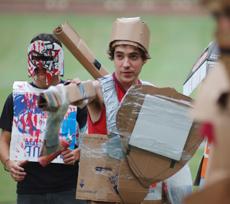Grayson Cave, his father and their bagpipes led a procession of about 30 warriors as they marched from Pullen Park to the battleground Wednesday night.
In this case, the battleground was the Court of North Carolina and the warriors were students clad in cardboard armor.
Cave, a sophomore in engineering, said he and his father took the seven minute procession down Pullen Road and through campus to the designated battleground. The warriors marched to four traditional Scottish songs, including “Scotland the Brave.”
The battle began at 6 p.m.
From two sides of the Court of North Carolina, squadrons of red- and yellow-clad warriors rushed toward each other, weapons held high and chants filling the air above.
When they collided, red meshing with yellow and shears of armor falling to the ground, there was no carnage — just a few scrapes.
Some, like Alex Bodnarchuk, a junior in industrial design, even walked away unscathed.
That’s because he has cardboard armor construction down to a science.
Each of the warriors — there were about 30 on the Court of North Carolina that day — made their suits of armor out of cardboard, tape and either red or yellow paint. They had an hour before the march from Pullen Park to the Court of North Carolina to create their battle gear, including masks, body armor, shields and clubs.
Bodnarchuk did most of his preparation in the design studio while others built their suits in Pullen Park. In studio, he created the centerpiece of his outfit: a helmet.
“I made that ahead of time,” he said. “I wanted it to be cool.”
He said he found an old mannequin and covered its head with a piece of paper. He traced the general shape of the helmet, placed the design over a piece of cardboard and cut it out with a sharp knife.
The process took about 30 minutes. When he was done, he walked to Pullen Park, where he spent the next 20 minutes creating his body armor and weapons.
Like the rest of those participating in the battle, he had to find a way to effectively make a suit that would protect him from his enemies’ weapons.
He said he traced the outline of his arm on pieces of cardboard, cutting against the grain and allowing for extra room to protect the sides of his arms. He made a sheath for a sword and flaps for shoulder pads.
It was all done with one goal: agility.
“I used light armor because I wanted to be more mobile,” he said. “I was able to run around the guys in huge suits. It was light enough to do all kinds of crazy stuff.”
With two weapons in hand and one in the sheath, his light suit allowed him to pick up his opponents’ weapons when they dropped them. He said although his armor was light, his forearm guards deflected any hits.
Eileen McDonough took a different approach.
McDonough, a sophomore in architecture, covered herself completely in cardboard. She said the technique was effective, though it didn’t provide her the same agility as Bodnarchuk. The skirt she made was “just fashionable,” and her box torso didn’t allow her to bend down.
“I didn’t need to bend down, though,” she said.
Her main guard against battle wounds was a club she made of packed cardboard.
“You don’t really realize it, but packing cardboard together makes a really, really heavy weapon,” she said.
Despite different armor production methods, both she and Bodnarchuk were on the winning red team.
“There was a lot more of the opposing team’s armor and shears of cardboard on the ground when I left,” Bodnarchuk said.








